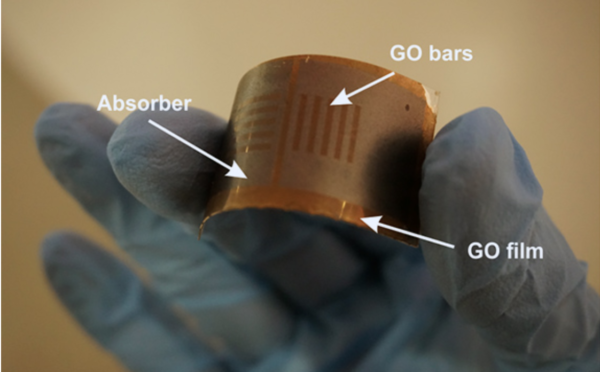Ultrathin graphene film
The challenge: To achieve broadband absorption of unpolarised light over a wide range of angles in a large-area ultra-thin film — critical for application in photovoltaics, photodetectors, thermal emitters and optical modulators.
The breakthrough: A 90-nanometre (1000 times finer than a human hair) material that can rapidly heat up to 160o Celsius under natural sunlight in an open environment. The metamaterial absorber consists of alternating graphene and dielectric layers including a grating that achieves broadband absorption over angles of up to 60o. The low-cost, flexible, robust film is produced by laser nanofabrication, making it scalable and suitable for industrial use.

Image: Swinburne University of Technology
The research team: The project is a collaboration between University of Sydney, Swinburne University of Technology and the Australian National University (ANU), and is funded by an Australian Research Council Discovery Project grant.
The potential impact: The material offers a pathway to development of new thermovoltaic (direct conversion of heat to electricity) systems; solar-powered seawater desalination and infrared light sources and heaters. It also has potential as an “invisible cloaking technology”, in which the large-scale thin films could enclose objects to be hidden — coal-fired power stations, perhaps?
What the researchers say: “The physical effect causing this outstanding absorption in such a thin layer is quite general, and thereby opens up a lot of exciting applications,” says Dr Bjorn Sturmberg, Research Leader of the Battery Storage and Grid Integration Program at ANU
Learn more: The research is published in Nature Photonics.
Renewable thermal solution for energy-intensive industries
The challenge: Some 20% of global fossil-fuel emissions are today produced by industry, primarily as a result of burning natural gas to create heat for a variety of manufacturing processes. There is a need for a low-cost, renewable energy solution to this source of climate-altering pollution.
The breakthrough: A sauna-like, air-based, encapsulated phase change material (EPCM) storage system. Much simpler than its technical description, the technology uses solar-PV or wind energy to heat electrical elements that in turn heat rocks packed around them; these components are enclosed within a stainless-steel tank, and a fan forces heated air out of the tank. Temperatures of the directed hot air can be adjusted between 150o Celsius and 700o Celsius by simply changing the fan speed. The latest 1.5 MWh thermal prototype will be around 1.5 metres tall and one meter wide at the base, and is expected to be powered by a 250 KWh solar PV system.
The research team: The system was developed by a team working with researcher Rhys Jacob at the University of South Australia’s Barbara Hardy Institute, which is dedicated to discovering and refining solutions for economic and community sustainability.
The potential impact: The system is designed to greatly reduce reliance on natural gas, thereby mitigating the cost impacts of fluctuating gas prices, and radically reducing industry emissions as a result of burning a fossil fuel. The rocks provide effective storage of heat at a much lower cost than equivalent battery storage, and will generally store enough heat to cover fluctuations in renewable energy sources. But the system can can be run in conjunction with gas-fired heating units, to provide a 24-hour heat supply when needed. Jacob says it can also be used as “a pre-heater in applications like cement production, which requires air temperatures up to 1400o Celsius. He says 700o Celsius is directly applicable to industries such as paper milling, mineral processing, food processing and agriculture — where it might be used for drying seeds or grain.
What the researchers say: “One key advantage of this system is current staff in most operations could maintain it without any training, which ensures it is extremely easy to integrate into an existing business,” says Jacob.
Learn more: The research is published in ScienceDirect.
Householders favour an Airbnb model for sharing spare solar power
The challenge: Households are considering feeding excess solar power into the grid for collective use as a way of sharing energy with other households — but they want to be sure their clean, home-made watts benefit people who need need them, rather than the big energy companies. The complexity of dealing with the energy sector, and distrust of major energy retailers has formed a barrier to development of sharing schemes.
The breakthrough: The tool isn’t here yet, but a new report, Engaging households towards a future grid has identified that people able to generate energy from solar systems would be interested in a sharing platform somewhat similar to Airbnb and Uber that would allow them to trade and share green energy.

Image: Sunnova
The research team: Consumer advocacy group Energy Consumers Australia funded behaviour-change and social researchers from RMIT University and Monash University to interview people in 51 households (both with and without installed solar systems) across Brisbane, Sydney, Canberra, Melbourne and Adelaide. Their aim was to understand how consumers want to engage in the transformation of Australia’s electricity system.
The potential impact: Provision of an effective platform could assist transition to new energy technologies, thus reducing consumer electricity bills and load on the grid, and restore a level of consumer trust in the Australian energy system.
What the researchers say: “As has been reported in cities with high uptake of Airbnb and other sharing platforms, there is potential for some people to miss out or be disadvantaged in the sharing economy,” said report lead author Dr Larissa Nicholls from RMIT Centre for Urban Research. “Programs and platforms need to ensure that consumers are the primary beneficiaries, and rules and regulations need to address equity concerns.”
Learn more: Read the full report. The researchers are formulating an engagement strategy for the consumer sector, which is expected to be released later this year.
This content is protected by copyright and may not be reused. If you want to cooperate with us and would like to reuse some of our content, please contact: editors@pv-magazine.com.









1 comment
By submitting this form you agree to pv magazine using your data for the purposes of publishing your comment.
Your personal data will only be disclosed or otherwise transmitted to third parties for the purposes of spam filtering or if this is necessary for technical maintenance of the website. Any other transfer to third parties will not take place unless this is justified on the basis of applicable data protection regulations or if pv magazine is legally obliged to do so.
You may revoke this consent at any time with effect for the future, in which case your personal data will be deleted immediately. Otherwise, your data will be deleted if pv magazine has processed your request or the purpose of data storage is fulfilled.
Further information on data privacy can be found in our Data Protection Policy.